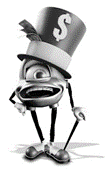- Home
- News & Insights
- Insights
- EU General Court dec…
- Auf dieser Seite
21. Juni 2023
Brands Update - June 2023 – 3 von 5 Insights
What is the scope of protection of a figurative EUTM? EU General Court decision concerning fantasy figures suggests it might be narrower than thought
- In-depth analysis
In Zitro v EU Intellectual Property Office (EUIPO), the EU General Court has dismissed an appeal against a decision that two figurative trade marks representing fantasy figures were not similar. This decision is an unusual shift away from the Court's general approach to judging similarity of figurative marks.
What has happened?
-
This case concerns the visual and conceptual similarities between two figurative trade marks. The marks at issue were two fantasy figures – full-body illustrations of figures with large heads wearing prominent top hats bearing a single letter.
-
-
In August 2018, e-gamings s.r.o. filed an EU trade mark (EUTM) application for the first figure above. Zitro International Sàrl opposed that application based on a likelihood of confusion with various earlier trade marks it owned, including one covering the second figure above. Both marks covered various goods/services relating to online gaming.
-
The EUIPO's Opposition Division decided that there was no likelihood of confusion between the marks as they are not similar, a decision upheld by the Board of Appeal. On a further appeal, the General Court has now agreed.
-
This decision on similarity is surprising given previous decisions of the EUIPO and General Court. Some commentators might argue that the comparison between the two marks was too granular and failed to consider the overall similarities between the marks and the imperfect recollection of consumers. Had the marks been held to have at least a low degree of overall similarity, it would still have been open to the Court (and the tribunals before it) to find no likelihood of confusion.
-
It is too early to say yet whether the decision represents a change of approach to judging similarity (and likelihood of confusion) at EU level. There have been other recent decisions which might suggest that the bar for similarity is being set slightly higher than it has been in the past (see our article here) but not enough (yet) for there to be a definite trend.
-
Either way, the decision is a useful reminder that trade marks protect the manifestation of an idea in the form of the mark applied for, not the idea itself.
-
The decision also serves as a reminder for prospective appellants to the General Court that it will not rule on arguments directed at the Opposition Division's decision. It is the decision of the Board of Appeal that is being appealed. The General Court will only consider arguments directed at that decision.
- the e-gamings figure has two eyes whereas the Zitro figure has only one
- the e-gamings figure shows two rows of teeth, rather than one
- the hats are tilted in different directions on the respective marks
- one hat bears the letter "B", the other a dollar $ sign
- the Zitro figure's arms are positioned one on its hip, the other holding a walking stick, whereas the e-gamings figure is positioned with both arms open
- the Zitro figure's feet are together, and the caps of its shoes are black
-
the e-gamings figure has visible eyebrows.
- The Board had failed to consider the visual similarities between the marks, and the Opposition Division had given too much weight to the differences between the marks, which relate to small details rather than more prominent elements.
- The public would pay more attention to the more prominent elements of the marks which are similar. The examination of the overall impression created by both marks was incorrect.
- The letters "B" and the "$" sign should not be taken into account as they are barely visible.
- The relevant pubic would perceive both figures as bingo or lottery balls – they are conceptually similar.
-
Consumers generally have an imperfect recollection of trade marks, so the differences between the marks are offset by the similarities and therefore a finding of a likelihood of confusion cannot be ruled out.
- While the marks shared certain features, the way those features were represented in the marks was sufficient to produce a different overall impression. Even if consumers cannot perfectly recall the details of each mark, they will be able to identify the differences between the marks so will not link them.
- It was not possible to carry out a true aural comparison between the marks, as no specific word could be attributed exactly to the marks which represent abstract fantasy figures.
- The mere fact that both marks consist of fantasy figures and the parties' offerings are online gambling/casino games was not enough for a finding of conceptual similarity.
 |
 |
| The mark applied for by e-gamings | The earlier mark owned by Zitro |
Want to know more?
The Opposition decision
The parties are both providers of online games, with a particular focus on online casino/gambling. Zitro filed an opposition against e-gamings' EUTM application based on Article 8(1)(b) of the EUTM Regulation (EUTMR), which states that, "Upon opposition by the proprietor of an earlier trade mark, the trade mark applied for shall not be registered:… if, because of its identity with, or similarity to, the earlier trade mark and the identity or similarity of the goods or services covered by the trade marks there exists a likelihood of confusion on the part of the public in the territory in which the earlier trade mark is protected…".
While Zitro chose a wide range of figurative marks as the bases for opposition, the key comparison was between the figures depicted above.
The Opposition Division pointed to the visual differences between the marks as follows:
The Opposition Division found that the marks were only similar to the extent that they both depict a figure with a head, hands, legs, teeth, gloves, shoes and a hat. The other visual elements of the marks and how all elements are presented played a "very important role" and had a "fundamental impact" on the visual impression created by the marks.
The Opposition Division decided that an aural comparison could not be properly carried out since only the signs on the hats could be pronounced – "B" and "$".
Conceptually, the marks had some similarity in that they both convey the concepts of a figure wearing a hat. However, the Opposition Division held that the other elements of the marks evoked different concepts which were not shared across both marks. It was therefore decided that they were conceptually similar only to a low degree.
The Board of Appeal decision
Zitro appealed the above to the Board of Appeal. That appeal was dismissed. The Board of Appeal decided that the marks were dissimilar visually and dissimilar (or neutral) aurally. The marks were therefore dissimilar overall.
The General Court decision
Zitro appealed the Board of Appeal's decision to the General Court, arguing that:
The General Court dismissed the appeal, holding that:
In dieser Serie
Match.com - honest concurrent use is not a stand-alone defence to infringement, says Court of Appeal
21. Juni 2023
von Louise Popple


